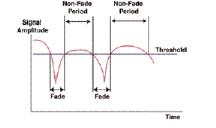CHAP 2 SYSTEM ASPECTS OF SMART
ANTENNA
2.1 Key characteristics of smart antennas Technology
An understanding of signal propagation environment and channel
characteristics is significant to the efficient use of a transmission medium.
In recent years, there have been signal propagation problems associated with
conventional antennas and interference is the major limiting factor in the
performance of mobile communication.
Thus, the introduction of smart antennas is considered to have
the potential of leading to a large increase in mobile communication systems
performance.
A smart antenna system in the mobile communication posses the
following key characteristics:
§ Larger Range Coverage - Smart
antennas provide enhanced coverage through range extension, whole filling, and
better building penetration [13].
§ Reduced Initial Deployment Cost
-When the number of subscribers increases in the network, system capacity
can be increased at the expense of reducing the coverage area and introducing
additional cell sites. Nevertheless, smart antenna can ease this problem by
providing larger early cell sizes and thus, initial deployment cost for the
mobile system can be reduced through range extension [14].
§ ??Reduced Multipath Fading -
The reduction variation of the signal (i.e., fading) greatly enhances system
performance because the reliability and quality of a mobile communications
system can strongly depend on the depth and rate of fading [15].
§ Better Security - The
employment of smart antenna systems diminish the risk of
connection tapping. The intruder must be situated in the
similar direction as the user as seen from the transmitter base station.
§ Better Services - Usage of
the smart antenna system enables the network to have
access to spatial information about the users. This
information can be used to assess the positions of the users much more
precisely than in existing network. This can be applied in services such as
emergency calls and location-specific billing [15].
§ Power efficiency -Combine the inputs
to multiple elements to optimize available processing gain in the downlink
(toward the user)
§ Increased Capacity - Precise
control of signal nulls quality and mitigation of interference combine to
frequency reuse reduce distance improving capacity. Adaptive technologies such
as space division multiple access support the reuse of frequencies within the
same cell [16] [17].
2.2 Signal Propagation: Multipath and cochannel
Interference
2.2.1 Multipath and problem associated
with it.
Multipath is a condition where the transmitted radio signal is
reflected by physical features/structures, creating multiple signal paths
between the base station and the user terminal.

Fig
2.1: The effect of Multipath on a mobile user[8].
One problem resulting from having unwanted reflected signals
is that the phases of the waves arriving at the receiving station often do not
match. The phase of a radio wave is simply an arc of a radio wave, measured in
degrees, at a specific point in time.
Fig.2.2. illustrates two out-of-phase signals as seen
by the receiver.

Fig
2.2: Two out-of-Phase Multipath Signal [8].
Conditions caused by multipath that are of primary concern are
as follows:
§ ?Fading: When the waves of multipath
signals are out of phase, reduction in signal strength can occur. One such type
of reduction is called a fade; the phenomenon is known as "Rayleigh fading" or
"fast fading"[8].
A fade is a constantly changing, three-dimensional phenomenon.
Fade zones tend to be small, multiple areas of space within a multipath
environment that cause periodic attenuation of a received signal for users
passing through them. In other words, the received signal strength will
fluctuate downward, causing a momentary, but periodic, degradation in
quality.

Fig
2.3:.Representation of Fade Effect on User Signal [8].
§ Phase cancellation: When waves of two
multipath signals are rotated to exactly 180° out of phase, the signals
will cancel each other. While this sounds severe, it is rarely sustained on any
given call (and most air interface standards are quite resilient to phase
cancellation). In other words, a call can be maintained for a certain period of
time while there is no signal, although with very poor quality. The effect is
of more concern when the control channel signal is canceled out, resulting in a
black hole, a service area in which call set-ups will occasionally fail [8].

Fig
2.4: Illustration of Phase Cancellation [8].
§ Delay spread: The effect of multipath
on signal quality for a digital air interface (e.g., TDMA) can be slightly
different. Here, the main concern is that multiple reflections of the same
signal may arrive at the receiver at different times. This can result in
intersymbol interference (or bits crashing into one another) that the receiver
cannot sort out.
When this occurs, the bit error rate rises and eventually
causes noticeable degradation in signal quality.
| 

